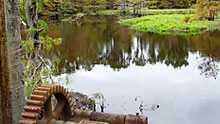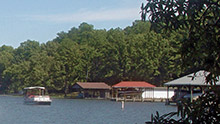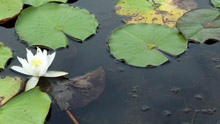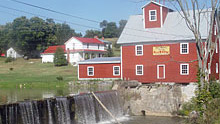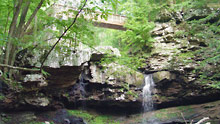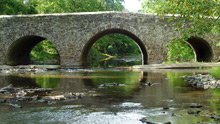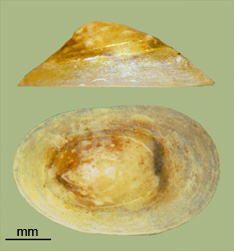> Habitat & Distribution
Ferrissia rivularis ranges throughout most of North America east of the Rockies, being found attached to rocks, cobbles and macrophytes in rivers, streams, and northern lakes (Basch 1963, Clarke 1981, Walther et al. 2010). Populations seem to become more widespread in cooler, well-oxygenated waters at more northern latitudes. The limpet is common in mountainous ecoregions from the Blue Ridge west through the Appalachians, Allegheny and Interior Plateaus of the Midwest, Kentucky and Tennessee, becoming less abundant across the Mississippi into The Great Plains. Ferrissia rivularis populations are sparse in the Piedmont ecoregion of the eastern United States, and absent from the Coastal Plain. FWGNA incidence rank I-5.
> Ecology & Life History
Ancylids are generally found to be grazers, with diets especially rich in diatoms (Dillon 2000: 77-79). Ferrissia rivularis was among the most herbivorous elements of a fauna of 75 macroinvertebrates inhabiting the Pennsylvania stream analyzed by Coffman (1971).
Burky (1971) reported a simple annual life cycle in one population of F. rivularis from New York and two generations per year in a second. The reproductive efforts of these two populations were in line with expectation from their adult sizes, leading Dillon (2000: 126 - 135) to suggest that they are Undifferentiated in their life history strategy. Jokinen s (1987) analysis of the distribution of F. rivularis (listed as F. parallela) in Connecticut and New York led her to classify it as a C-D tramp, potentially present in nearly every community. Dillon s (2000: 360-363) reanalysis of these data confirmed that F. rivularis populations in Connecticut seem to be Undifferentiated with respect to life history adaptation.
Self-fertilization seems to be widespread among the ancylids (Stadler et al. 1995, Dillon & Herman, 2009) although no data bearing directly on this question are available for populations of Ferrissia rivularis.
> Taxonomy & Systematics
Most of the older North American ancylid taxa were initially assigned to either the genus Ancylus or the genus Gundlachia, which were grouped into the subgenus Ferrissia by Walker (1903), raised to the full genus level in 1917.
Basch (1963) recognized five species in the genus Ferrissia - F. rivularis from stones, F. fragilis from vegetation and organic debris in flowing water, F. parallela on narrow-bladed plants in lentic environments, F. walkeri on broad-leaved plants in lentic environments, and F. mcneilli endemic to Alabama. The shell morphological criteria upon which his system was largely based seem to be subject to a great deal of ecophenotypic plasticity, however (Russell-Hunter et al. 1967, Dillon & Herman 2009). Walther et al. (2010) combined Basch's five taxa into two species, subsuming parallela under rivularis and walkeri and mcneilli under fragilis. Older synonyms of F. rivularis include tardus, depressus, and haldemani.
> Maps and Supplementary Resources
- Ferrissia distribution in drainages of The Ohio (2019)
- Ancylid distribution in Atlantic drainages (2023)
- Ferrissia distribution in the Tennessee/Cumberland (2022)
- Ferrissia distribution in The Great Plains (2024)
- Ancylid distribution in Georgia and the Florida panhandle (2025)
- Ferrissia rivularis on a stone in Kentucky, courtesy of T. Travis Brown.
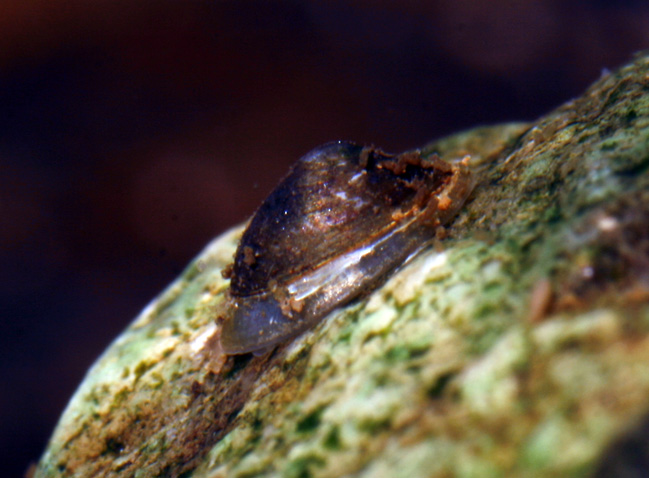
> Essays
- I reviewed the research findings of Andrea Walther and her colleagues suggesting that North America is inhabited by Two Species of Ferrissia on 8Dec10. The essay includes a couple nice figures comparing rivularis with fragilis.
- See my post of 26Sept14 for good, comparative figures illustrating "The egg masses of freshwater pulmonate snails."
- See my essay of 11Jan17 for an interesting photo of Ferrissia on the back of a Dytiscid beetle - "A previously unrecognized symbiosis?"
> References
Basch, P. (1959a) the anatomy of Laevapex fuscus, a fresh-water limpet (Gastropoda: Pulmonata). Misc. Publ. Mus. Zool. Univ. Michigan 108: 1 - 56.
Basch, P. (1959b) Studies on the development and reproduction of the fresh-water limpet Ferrissia shimekii (Pilsbry). Trans. Amer. Micros. Soc. 78: 269 - 276.
Basch, P. (1959c) Status of the genus Gundlachia (Pulmonata: Ancylidae). Occ. Pprs. Mus. Zool. Univ. Michigan 602: 1 - 9.
Basch, P. (1963) A review of the recent freshwater limpet snails of North America. Bull. Mus. Comp. Zool. Harvard, 129, 399-461.
Blinn, D., R. Truitt, & A. Pickart. (1989) Feeding ecology and radular morphology of the freshwater limpet Ferrissia fragilis. J. N. Am. Bentho. Soc., 8: 237-242.
Burky, A. (1971) Biomass turnover, respiration, and interpopulation variation in the stream limpet Ferrissia rivularis (Say). Ecol. Monog., 41: 235-251.
Coffman, W. (1971) Energy flow in a woodland stream ecosystem: I. Tissue support trophic structure of the autumnal community. Arch. Hydrobiol., 68: 232-276.
Dillon, R. T., Jr. (2000) The Ecology of Freshwater Molluscs. Cambridge University Press, United Kingdom. 509 pp.
Dillon, R. T., & J. J. Herman (2009) Genetics, shell morphology, and life history of the freshwater pulmonate limpets Ferrissia rivularis and Ferrissia fragilis. J. Freshwat. Ecol. 24: 261 - 271. [PDF]
Hoff, C. C. (1940) Anatomy of the ancylid snail, Ferrissia tarda (Say). Trans. Amer. Micros. Soc. 59: 224-242.
Hubendick, B. (1964) Studies on Ancylidae, The subgroups. Meddelanden Fran Goteborgs Musei Zoologiska Avendelining, 137. (Goteborgs Kungl. Vetenskaps-Och Vitterhets-Samhalles Handlingar. Sjatte Foljden. Ser. B.) 9, 1-72.
Jokinen, E. (1983) The freshwater snails of Connecticut. Hartford, Connecticut, State Geol. Nat. Hist. Survey Bull. 109. 83 p.
Jokinen, E. (1985) Comparative life history patterns within a littoral zone snail community. Verh. Internat. Verein, Limnol., 22: 3292-3399.
Jokinen, E. (1987) Structure of freshwater snail communities: Species-area relationships and incidence categories. Amer. Malac. Bull. 5: 9 - 19.
Keating, S.T. & Prezant, R.S. (1998) Effects of stream chemistry on the distribution, growth, and diatom colonization of the freshwater limpet, Ferrissia rivularis. J. Freshwat. Ecol. 13: 67-77.
Russell-Hunter, W.D., M. L. Apley, A. J. Burky, & R. T. Meadows (1967) Interpopulation variations in calcium metabolism in the stream limpet, Ferrissia rivularis (Say) Science 155: 338-340.
Russell-Hunter, W.D., Burky, A.J. & Russell-Hunter, R.D. (1981) Interpopulaton Variation in Calcareous and Proteinaceous Shell Components in the Stream Limpet, Ferrissia rivularis. Malacologia 20: 255-266.
Stadler, T., S. Weisner, & B. Streit (1995) Outcrossing rates and correlated matings in a predominantly selfing freshwater snail. Proc. R. Soc. Lond. B 262: 119-125.
Walther, A. C., J. B. Burch and D. O Foighil (2010) Molecular phylogenetic revision of the freshwater limpet genus Ferrissia (Planorbidae:Ancylinae) in North America yields two species: Ferrissia (Ferrissia) rivularis and Ferrissia (Kincaidilla) fragilis. Malacologia 53: 25-45.
Walther, A. C., T. Lee, J. B. Burch, and D. O'Foighil (2006) Confirmation that the North American ancylid Ferrissia fragilis (Tryon 1863) is a cryptic invader of European and East Asian freshwater ecosystems. J. Moll. Stud. 72: 318 - 321.
Walker, B. (1903) Notes on eastern American ancyli. Nautilus 17: 13 - 19, 25 - 31.
Walker, B. (1917) A revision of the classification of the North American patelliform Ancylidae, with descriptions of new species. The Nautilus 31: 1 - 10.

